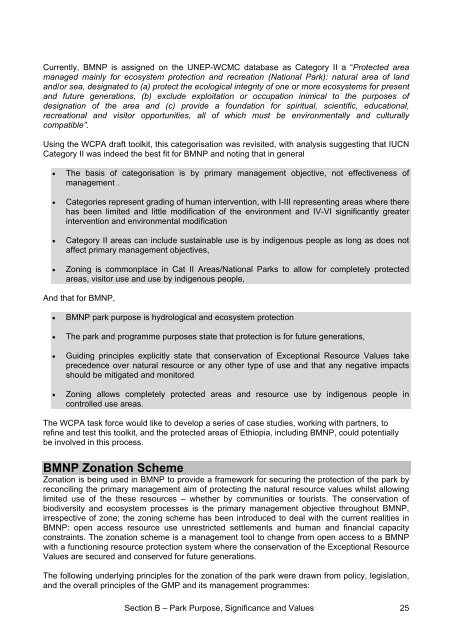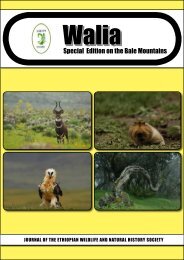Bale Mountains National Park - Zoologische Gesellschaft Frankfurt
Bale Mountains National Park - Zoologische Gesellschaft Frankfurt
Bale Mountains National Park - Zoologische Gesellschaft Frankfurt
You also want an ePaper? Increase the reach of your titles
YUMPU automatically turns print PDFs into web optimized ePapers that Google loves.
Currently, BMNP is assigned on the UNEP-WCMC database as Category II a “Protected area<br />
managed mainly for ecosystem protection and recreation (<strong>National</strong> <strong>Park</strong>): natural area of land<br />
and/or sea, designated to (a) protect the ecological integrity of one or more ecosystems for present<br />
and future generations, (b) exclude exploitation or occupation inimical to the purposes of<br />
designation of the area and (c) provide a foundation for spiritual, scientific, educational,<br />
recreational and visitor opportunities, all of which must be environmentally and culturally<br />
compatible”.<br />
Using the WCPA draft toolkit, this categorisation was revisited, with analysis suggesting that IUCN<br />
Category II was indeed the best fit for BMNP and noting that in general<br />
• The basis of categorisation is by primary management objective, not effectiveness of<br />
management .<br />
• Categories represent grading of human intervention, with I-III representing areas where there<br />
has been limited and little modification of the environment and IV-VI significantly greater<br />
intervention and environmental modification<br />
• Category II areas can include sustainable use is by indigenous people as long as does not<br />
affect primary management objectives,<br />
• Zoning is commonplace in Cat II Areas/<strong>National</strong> <strong>Park</strong>s to allow for completely protected<br />
areas, visitor use and use by indigenous people,<br />
And that for BMNP,<br />
• BMNP park purpose is hydrological and ecosystem protection<br />
• The park and programme purposes state that protection is for future generations,<br />
• Guiding principles explicitly state that conservation of Exceptional Resource Values take<br />
precedence over natural resource or any other type of use and that any negative impacts<br />
should be mitigated and monitored<br />
• Zoning allows completely protected areas and resource use by indigenous people in<br />
controlled use areas.<br />
The WCPA task force would like to develop a series of case studies, working with partners, to<br />
refine and test this toolkit, and the protected areas of Ethiopia, including BMNP, could potentially<br />
be involved in this process.<br />
BMNP Zonation Scheme<br />
Zonation is being used in BMNP to provide a framework for securing the protection of the park by<br />
reconciling the primary management aim of protecting the natural resource values whilst allowing<br />
limited use of the these resources – whether by communities or tourists. The conservation of<br />
biodiversity and ecosystem processes is the primary management objective throughout BMNP,<br />
irrespective of zone; the zoning scheme has been introduced to deal with the current realities in<br />
BMNP: open access resource use unrestricted settlements and human and financial capacity<br />
constraints. The zonation scheme is a management tool to change from open access to a BMNP<br />
with a functioning resource protection system where the conservation of the Exceptional Resource<br />
Values are secured and conserved for future generations.<br />
The following underlying principles for the zonation of the park were drawn from policy, legislation,<br />
and the overall principles of the GMP and its management programmes:<br />
Section B – <strong>Park</strong> Purpose, Significance and Values 25
















